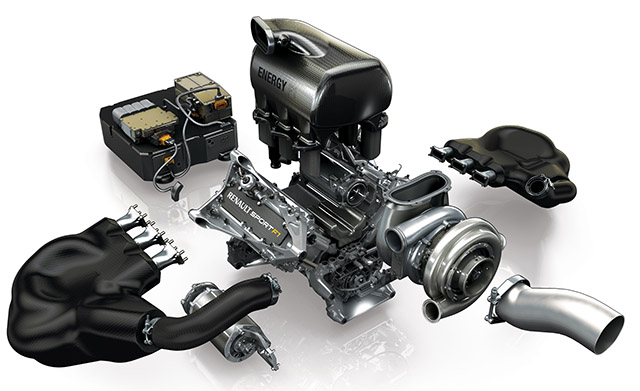ICE?
In the context of this article, ICE has nothing to do with frozen water, but rather everything to do with Formula One engines from this season onwards. With the current Formula One power units we need to distinguish between the several systems these units consist of, and one of them is the ICE – the Internal Combustion Engine. I am not involved in 2014 Formula One ICE engineering but in this article I will try to make an educated guess about the differences between the 2014 and pre-2014 crankcases, based on the introduction of the turbo engines.
Let us start with the peak firing pressure (PFP), which is one of the most decisive factors in crankcase design. With the introduction of the turbo engines, the PFP increased from just over 100 bar to around 200 bar. This dictates the strength concept of the engine and therefore the major dimensions, such as cylinder distance, main bearing and cylinder head bolt sizes and crankshaft dimensions.
The Formula One V8 engines of 2013 were regulated to a 98 mm maximum bore with a cylinder spacing dictated at 106.5 mm, leading to a distance-to-bore ratio of 1.10. The 2014 Formula One engines, however, do not have a fixed bore spacing but a mandated bore of 80 mm. Given the higher load on the piston system, and subsequently on the block-head interface, let us estimate that this ratio will be increased slightly, to 1.15. This would lead to a cylinder distance of 92 mm. Calculating the overall block length, this would then lead to a reduction of about 14 mm per cylinder. Adding in the reduction from eight cylinders to 6, this would lead to an estimated reduction in length of 150 mm. This of course is only the ICE; all other power unit systems will need to be taken into account as well.
Looking further at the crankcase and the dimensions, we can compare bore sizes and the respective maximum gas loads. With the V8s, the maximum pressure of 100 bar would work on an effective diameter of a little over 98 mm (the gasket diameter is always somewhat larger than the bore, let us say 102 mm). With the 2014 V6 turbo though, the maximum pressure of 200 bar is working on a diameter of 88 mm (again, gasket diameter). This means an increase in load on the piston (and therefore on the head as well) of about 25%. We’re talking here only about gas load, without taking into account the extra thermal loading because of increased specific power (from about 225 kW/l to about 300 kW/l).
To keep the engine from falling apart under these loads, the cylinder head bolt size would therefore have to be increased, which I estimate would be from something like an M11 to an M14.
Then, looking at the height, the effect of the longer stroke (about 40 mm to about 53 mm) and the subsequent increase of the con rod length needs to be taken into account. In addition, the higher PFP would require an increased compression height of the piston as well (which is of course related to piston material, which might even be steel nowadays). I would estimate an overall increase from crankcase centreline to the top deck of the crankcase of around 40 mm.
Earlier we saw that the thermal loading of the piston system and cylinder head has also significantly increased. Together with the gas force on the piston, this would mean a definite requirement for a stronger piston and increased dimensions on the bearing system of piston-con rod interface, as well as the crankshaft.
All in all, the introduction of the turbo engines has led to a significantly different crankcase. Where the length could be reduced considerably, the height went the other way. Owing to the enormous increase in PFP, the whole crankcase structure – including the cranktrain – has had to be engineered to withstand these loads, in the end leading to the regulatory increase in minimum engine mass from the 90 kg with the V8 Formula One engines to the 145 kg now. This in turn has led to a totally different power-to-weight ratio, a shocking decrease from 0.18 kg/kW to 0.31 kg/kW. What is also interesting to see – and this is a nice example of the fact that engines all look alike – is that the engine mass per litre engine size, now at about 90 kg/l against 40 kg/l for the V8s, are in the same range as current production engines.
 Fig. 1 - Detail of the Toyota RVX9 engine, with the cylinder head bolt spacing visible in the lower left corner. Also, several coolant ports between head and block (blue-coloured cavities) can be seen (Courtesy of Toyota Motorsport)
Fig. 1 - Detail of the Toyota RVX9 engine, with the cylinder head bolt spacing visible in the lower left corner. Also, several coolant ports between head and block (blue-coloured cavities) can be seen (Courtesy of Toyota Motorsport)

Fig 2 - Renault Sport F1’s engine for 2014, showing the ICE in the middle. Although not a very detailed image, one could imagine from the view that there is still a four-bolt connection between head and block
Written by Dieter van der Put